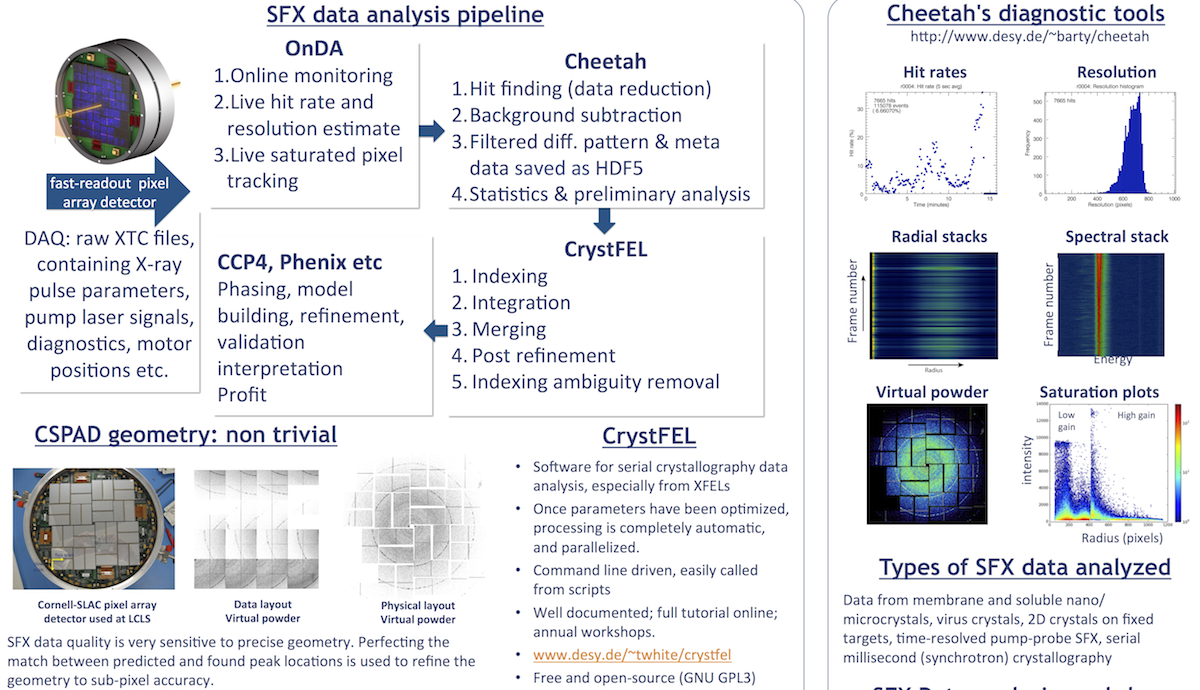-
Free Electron Lasers and Crystallography
29 Aug 2014 | Teaching Materials
Paul Adams (LBNL)
BioXFEL in the greater context of crystallography
-
Data Analysis and Sample Delivery
29 Aug 2014 | Teaching Materials
John Spence (ASU/LBNL)
How XFEL MX differs from MX and why we do it.
-
SFX Data Reduction and Preprocessing
29 Aug 2014 | Teaching Materials
Anton Barty (CFEL)
Photons, detectors and data streams: how to get at the data and what it records. Data reduction and pre-processing: how it works and how to optimize it.
-
Rapid Data Quality Feedback and Online Monitoring using CASS
29 Aug 2014 | Teaching Materials
Karol Nass (MPI)
Description of the layout of CASS software suite and its functionality on the LCLS online and offline data streams. Real time monitoring of the SFX experiment: hit rate, resolution, pixel saturation, 2D powder pattern. Rapid offline processing of the raw LCLS data: crystal hit …
-
Introduction to CrystFEL
29 Aug 2014 | Teaching Materials
Tom White (CFEL)
CrystFEL is a suite of programs that deal with viewing, indexing, integrating and merging serial crystallography data, evaluating its quality and simulating patterns. At the core of CrystFEL is an automated, high throughput processing pipeline which indexes and integrates each …
-
How good are my data?
29 Aug 2014 | Teaching Materials
Nick Sauter (LBNL)
A design goal of the data reduction package cctbx.xfel is to discover and apply the numerous systematic corrections necessary to correctly model XFEL diffraction images. Numerous challenges must be addressed to interpret serial femtosecond diffraction, including an inaccurate …
-
Practical considerations during processing of serial crystallographic XFEL data
29 Aug 2014 | Teaching Materials
Aaron Brewster (LBNL)
Fundamental differences exist between processing rotational data collected at a synchrotron source and data collected during a serial crystallographic XFEL experiment. Practical techniques will be described to enable the user to get the most out of their data using the …
-
From cctbx to cctbx.xfel and beyond
29 Aug 2014 | Teaching Materials
Johan Hattne (HHMI)
Algorithms to process X-ray diffraction images into accurate atomic models of macromolecules have undergone steady refinement over the past decades. As methods by which crystallographic diffraction patters are obtained are further developed, these techniques continue to provide …
-
Handling sample heterogeneity in serial crystallography
29 Aug 2014 | Teaching Materials
Oliver Zeldin (Stanford)
Serial crystallography data is made up of images obtained from a population of slightly in-homogenous crystals. We will discuss clustering and filtering approaches to (1) characterizing sample heterogeneity in unmerged data, and (2) identifying optimal sub-sets of images …
-
Winning the Battle of Signal vs. Noise
29 Aug 2014 | Teaching Materials
James Holton (UCSF/LBNL)
I will review the major sources of error that contribute to macromolecular crystallography (MX) data with a particular focus on MX data from X-ray Free Electron Lasers. The absolute limits will be defined, and the potential of new and future technologies for overcoming …
-
Clustering and main sources of variance of SFX data
29 Aug 2014 | Teaching Materials
Wolfgang Brehm (University of Konstanz)
Clustering approaches and variance analysis are explained using the example of the indexing ambiguity in serial crystallography. Recently published algorithms for detwinning and advancements thereof will be shown. Variance analysis can lead to a more …
-
BioXFEL Expert Panel Discussion
29 Aug 2014 | Teaching Materials
Expert Panel Discussion including:
Anton Barty, Michael Rossman, James Holton, Tom White, Wolfgang Brehm, Oliver Zeldin, John Spence, Karol Nass, Nick Sauter, Aaron Brewster, Johan Hattne
-
Psana Tutorial
03 Sep 2014 | Teaching Materials
Chris O'Grady (SLAC)
Psana is the main analysis tool developed by LCLS, upon which some other tools are based. It uses a combination of C++ and python. I will discuss recent psana developments and future plans. Recent developments include the ability to express complex analysis ideas with simple …
-
Cheetah Tutorial
03 Sep 2014 | Teaching Materials
Anton Barty (CFEL)
-
CASS and SFX SAD Tutorial
03 Sep 2014 | Teaching Materials
Karol Nass (MPI)
Extraction of diffraction images of the lysozyme Gadolinium derivative (Barends et al. Science 2013) from the raw LCLS format to HDF5 format. Integration of CrystFEL analysis with CASS start-up scripts. Ab initio SAD phasing of SFX data.
-
CrystFEL Tutorial
03 Sep 2014 | Teaching Materials
Tom White (CFEL)
-
cctbx.xfel Tutorial
03 Sep 2014 | Teaching Materials
Nick Sauter (LBNL)
Aaron Brewster (LBNL)
Oliver Zeldin (Stanford)




